The story of the Suzuki RM250 isn’t just about a single motorcycle. It’s about a dynasty of bikes, championships and riders that goes back to a glorious era in the history of motocross. Forty-five years ago, motocross was an obscure European sport. In America, we loved flat track and hill climbing. Even in Europe, road racing was a far more popular sport. No one really saw any future in the cult sport of motocross. No one, that is, besides a group of very insightful people at Suzuki. Back in 1965, Suzuki launched a massive development program to build the world’s best motocross bike. It wasn’t based on market research, computer forecasts or industrial analysis. It was all about gut instinct and passion.
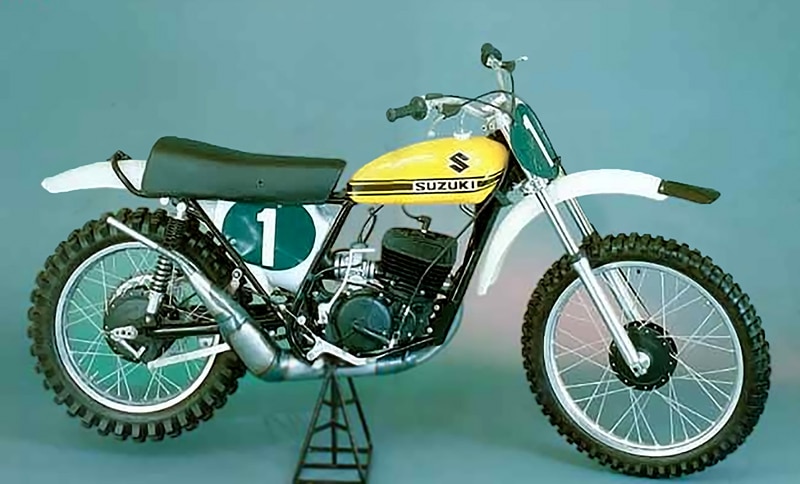
The program came to life through the efforts of Mr. Okano, General Manager of Research and Development, and Racing Manager Mr. Ishikawa. Both men were passionate about racing and for some reason, motocross captured their imagination. The first product of the program was the RH66, a prototype 250cc racer with a number of odd

features, like a crankshaft-mounted clutch. It wasn’t very good, and the limited production TM250 that followed wasn’t any better. Things didn’t really start happening until Suzuki hired Swede Olle Petersson in 1967 to both develop and race the machine. His first recommendation was for only one change to the existing bike. He told them to throw it away and start over. That set in motion an amazing success story that resulted in a legacy of World Championships, beginning with Joel Robert in 1970. Honda, Yamaha and Kawasaki were years behind and even the European makers were stunned.

THE PRODUCTION DISCONNECT
machines. From 1973 to 1975, Suzuki’s efforts in GP racing basically helped Honda and Yamaha sell motorcycles.
Something had to change. In 1975 Suzuki made a commitment to not only improve its production bikes, but to make them worthy of their works-bike counterparts. The TM line was abandoned and the Suzuki RMs were born. First a 125 that was half TM and half RM appeared, but in 1976 a pureblood line of RMs was offered including the RM250A. If you looked at that RM and compared it to the bike that carried Joel to his first championship six years earlier, it was clear that Suzuki’s racing and production departments were working together. From that point on, it can honestly be said that there was never a bad bike that carried the RM prefix.
THE RECORD BOOK
The RH70 was the breakthrough bike for Suzuki, carrying Robert and Geboers to first and second in the 1970 250 World Championship. Who got third place that year? Funny you should ask; it was none other than Roger DeCoster. Roger was on a CZ that year, but he would join Suzuki the next year to ride the 500 class.
Suzuki’s 250 championships would continue in Europe, including those won by Georges Jobe, Alessandro Puzar, Greg Albertyn and Michael Picheon. In the U.S., the works version of the RM only collected seven 250 National titles with Tony DiStefano, Kent Howerton, Greg Albertyn and Mark Barnett (in Supercross). Eventually, its MX legacy climaxed with Ricky Carmichael. But that was only part of the story. The RM made a great off-road bike. That world is traditionally dominated by European bikes like KTM and Husqvarna, but the Suzuki RM 250 made its mark there.Between the efforts of Randy Hawkins, Rodney Smith, Steve Hatch and Paul Edmondson, the RM or its blood brother the RMX captured 16 National Championships in GNCC, Enduro and Hare Scrambles. That’s more than any other Japanese motorcycle. The RM and RMX were also incredibly successful for American riders in the ISDE. Rodney Smith came very close to winning the event overall on an RM250 in 1992.
1968: Suzuki releases the first TM250 in very limited numbers. It is fragile and weird, and it shows a lot of CZ influence. But it is very similar to the original RH66 works bike with a number of expensive magnesium parts. It shows that Suzuki was paying attention to a world that other Japanese manufacturers don’t know exists.
1971: Suzuki’s next try at a production motocross bike is the orange TM400 Cyclone. It earns a reputation as one of the worst handling bikes ever made; a rap that only grows in legend. It is, nonetheless, the only production motocross bike available from a Japanese company.
1972 – 1973: The TM line grows. The Cyclone (now yellow, just like Roger’s bike) is joined by a TM250 Champion, a TM125 Challenger and a TM100 Contender. The 125 and 100 aren’t bad. The 250 and 400 are.
1975: The first RM appears in the form of the Suzuki RM125M. It still uses a motor from the TM, but the machine is more focused and more competitive, showing a hint of things to come. It has long travel suspension that is considered excellent in its day. It no longer has an oil pump; you have to mix your oil in the gas.
1976: The true RM line is born. The RM250A is a completely new bike with long-travel suspension that is considered to be the best of any production bike available. The 125 and 370 versions are new as well. The RM is on top, but Yamaha isn’t standing still and competition between the two companies is intense, with Honda joining in later. Updates come quickly and Suzuki has three new versions of the RM250 available over the next two years, dubbed the B, C and CII. The RM250CII in 1978 gets a plastic fuel tank and an aluminum swingarm.
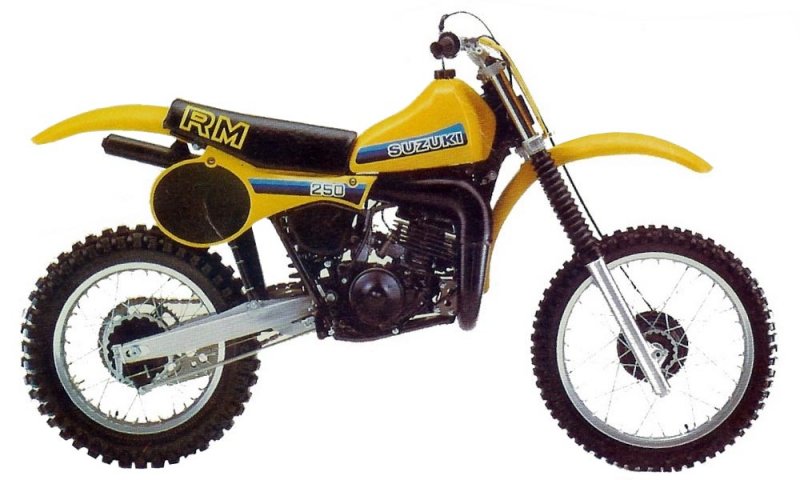
1981: Everything changes with the arrival of single-shock suspension. All four Japanese companies offer different configurations, but Suzuki’s “Full Floater” design is the best. Side note: Suzuki is sued by the original designer of the system. After a lengthy court battle, Suzuki is ordered to pay up based on the number of units sold.
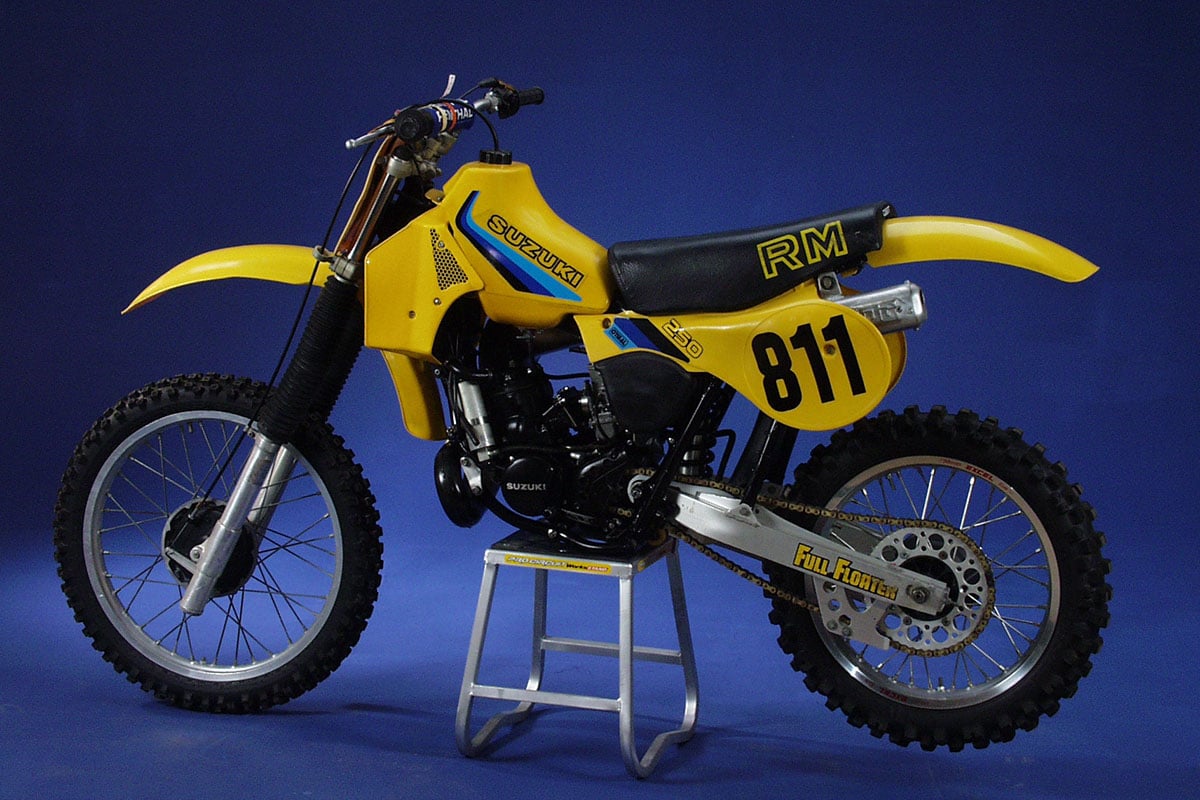
1982: The liquid-cooled RM250 of 1982 reigns supreme as the best 250 of the year. It’s faster, lighter and has better suspension than anything in the class. Honda, Yamaha and Kawasaki have off-years, but recover quickly. In 1983, the RM250 loses power and the other Japanese companies catch up. Over the next few years, the Suzuki doesn’t quite keep up with the rapid pace of technological improvement in the motocross world. If there are any dark years in the history of the RM, it is in the mid-’80s.
1986: The frame is redesigned and the rear suspension looses the big rocker arm on top, which is replaced by below-the-swingarm linkage. The motor lacks throttle response and peak power. The 1987 suspension is revised again, and the motor get blue paint, but during this period, the RM looses much of it magic.
1988: Suzuki catches up in a hurry when Bob Hannah becomes involved with production bike testing. The 1988 RM gets a new power valve and redesigned bodywork, and it is once again best in class. Its strong point is still suspension, but now it has competitive power, too. It’s in this era that Suzuki also earns the reputation for good cornering ability that continues to this day.
1989: Suzuki makes the first top-to-bottom change in years. Everything is different, and the bike is excellent. The most significant change is the switch to a case-reed motor. Another change is the inverted fork. This also marks the arrival of the RMX250 off-road bike, which was developed with the help of Randy Hawkins. The RMX is very successful, but goes almost unchanged for its entire production run of 10 years.
1994 Suzuki RM250
1993: The RM250 looks completely different, with large shrouds that cover the whole tank. The Dirt Bike test of the day charges that the bike is essentially the same in performance. This isn’t good, because Honda, Kawasaki and Yamaha are making fast improvements. Suzuki then enters a short period of mediocrity.
1996: Roger DeCoster, who had been working full time as Executive Editor of Dirt Bike Magazine, takes a job at Suzuki in 1995 and pushes for big changes with a short deadline. The result is an all-new bike in 1996. Its wildest feature is the return to a conventional fork. It also has an internal water pump. The bike is excellent, but gets a bad rap when Jeremy McGrath looses his 1997 Supercross title in his short tenure at Suzuki.

1999: The inverted fork is back. Suzuki makes very few changes to the RM250 in this period. The bikes strong points are suspension, power and cornering. Its weak points are its excessive weight and lack of straight-line stability. It finishes in the middle of most magazine shootouts.
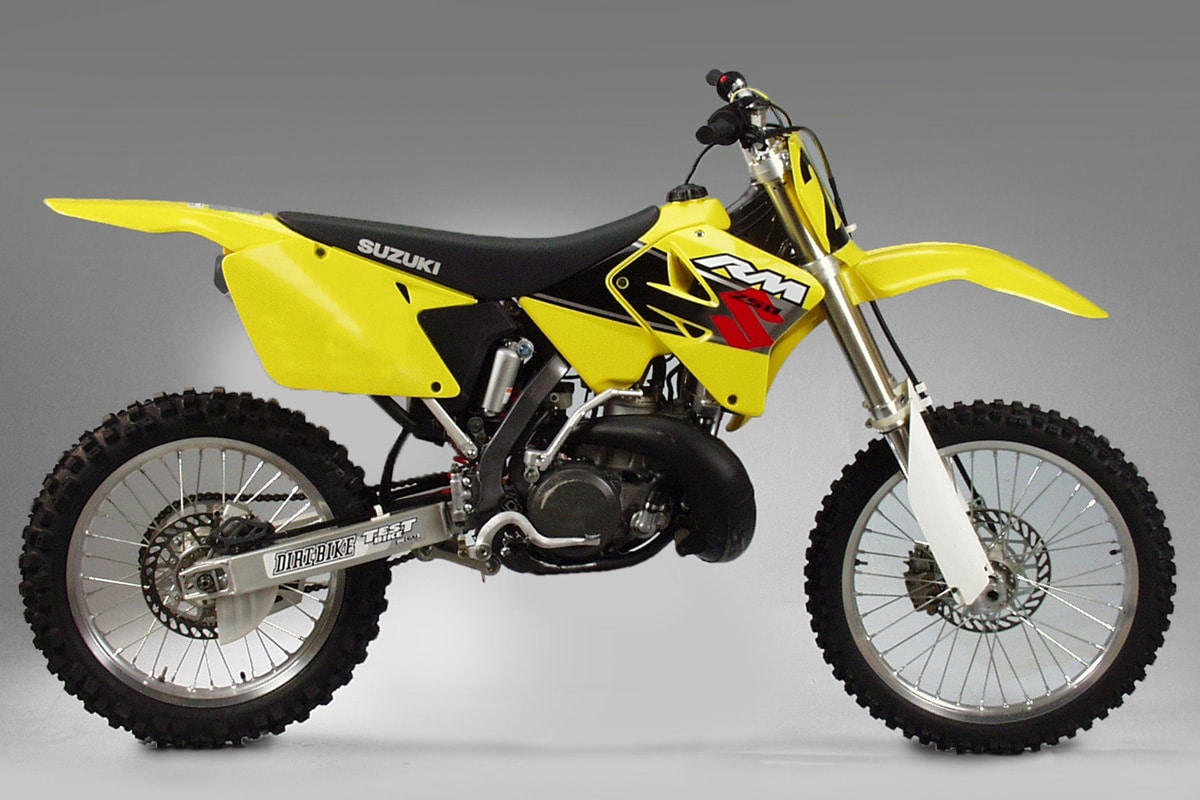
2001: This is the last big change for the Suzuki RM250. It gets a new frame and bodywork, new engine cases with an external water pump and a new power valve. At this point, the Suzuki is very close to the top of its game. So is Yamaha, and the two companies battle back and forth for the honor of top bike. Honda’s 01 CR is in the hunt, too, but then takes a step backward in 2002.
2008: Suzuki and Yamaha are alone among Japanese 250s by now. The two of them are basically at a draw; both have strong points and weak points, but there will be no more progress. Suzuki discontinues the RM in 2009. It‘s the end of what many consider to be the most successful model run in motocross history, from a pure performance point of view.
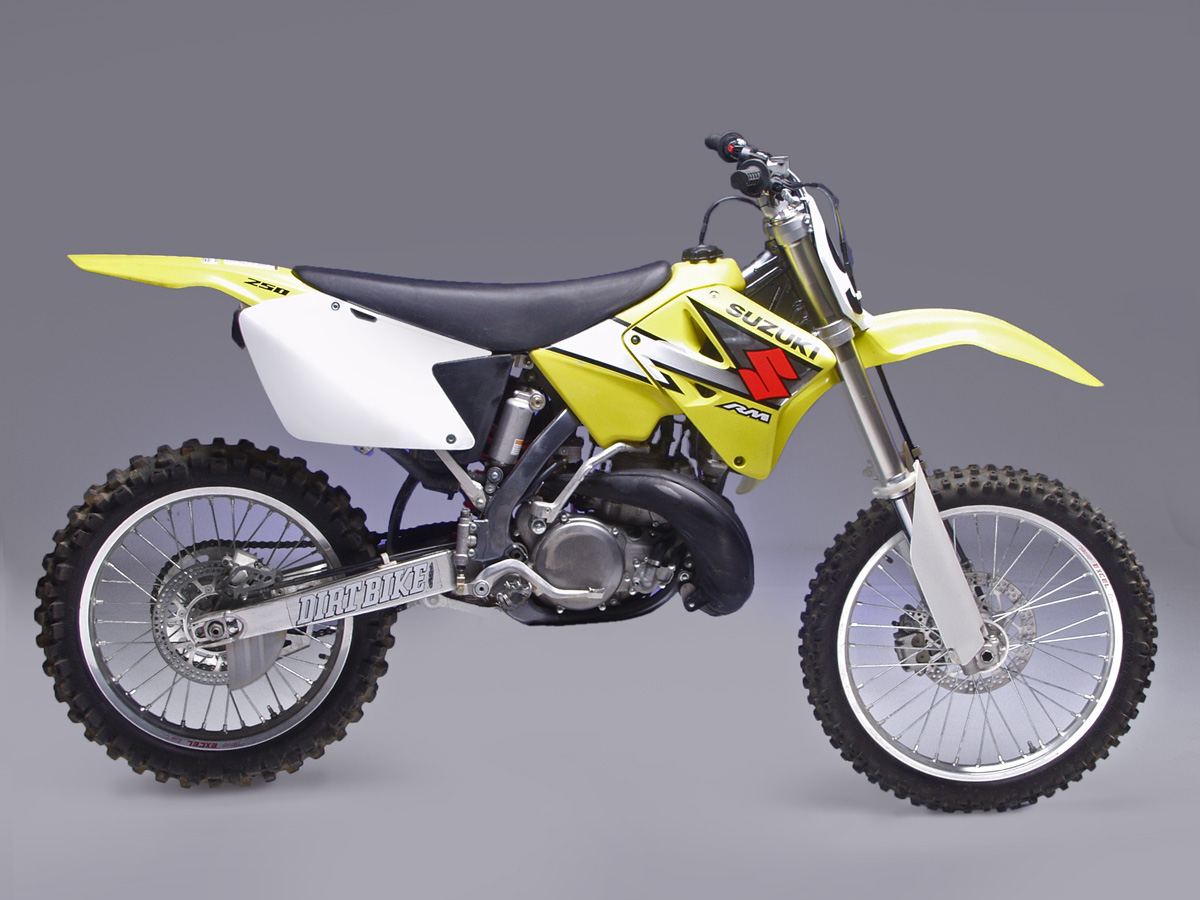
USED BIKES
Any used Suzuki RM250 from 2001 forward is a good find. The performance got better and better and probably peaked in 2005. The earlier models in this period were harder to jet. Most riders just gave up and ran race gas, mixed half and half with pump gas. By 2005 the jetting issues were sorted out. Suzukis tend to bring lower prices than Yamahas of the same year, simply because the Yamaha is still in production. Even Hondas have higher asking prices for no good reason. The RMs are better in every way.
The period from 1996 to 2000 is mixed. The RM250 was a good bike, but that internal water pump could leak and was difficult to repair. As with any bike that is over 10 years old, condition is the most important factor. Parts availability is generally very good.
Collectors love really old Suzukis. If you find an RM with the original aluminum fuel tank in good condition from 1976 to 1978, it’s like finding a Picasso in the attic. They dented easily and were replaced back in the day with plastic items. For a look at some classic Suzuki race bikes and intriguing stories from the works bike era, check out Terry Good’s website at www.mxworksbike.com.
Mike Alessi found a used RM250 on Craigslist and used it to win the Two-Stroke Championship
For a history of the Kawasaki KX500, click here.



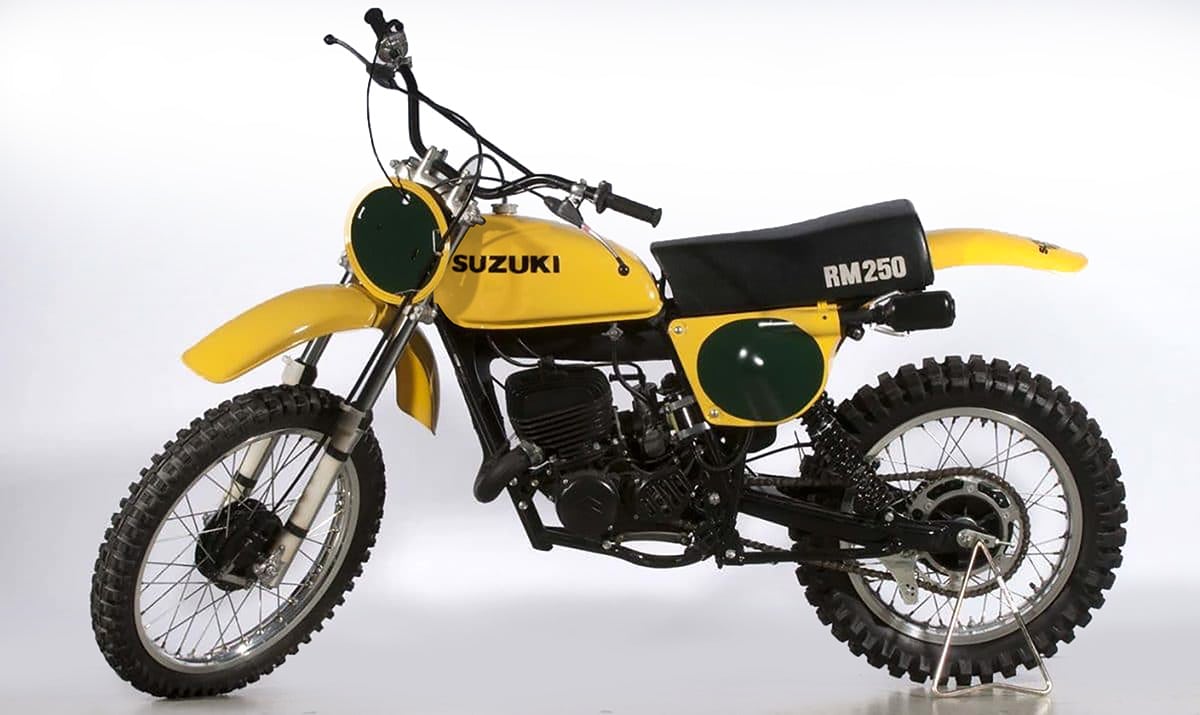

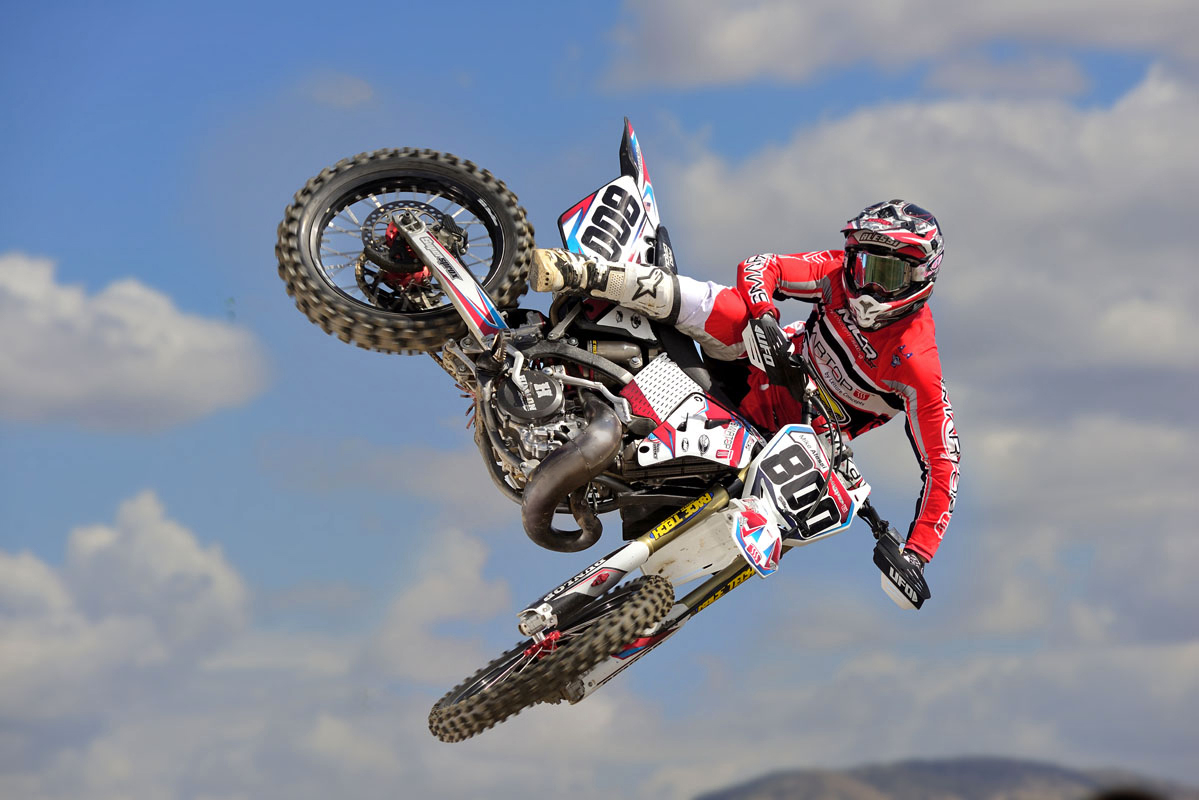

Comments are closed, but trackbacks and pingbacks are open.